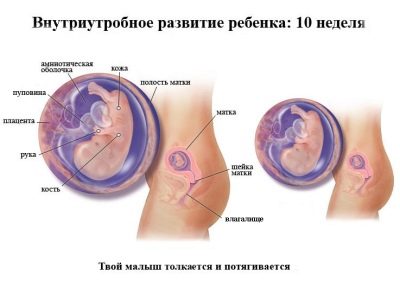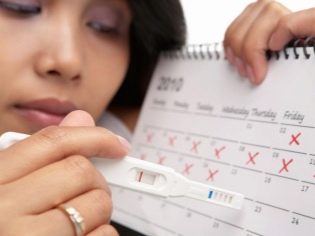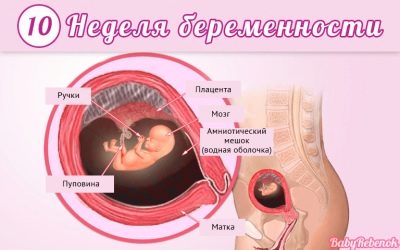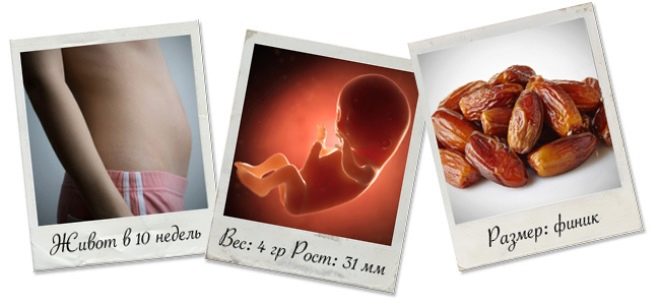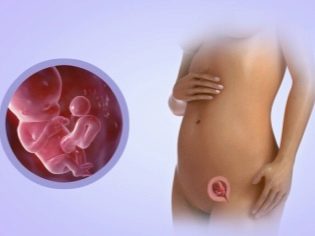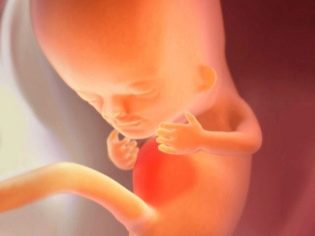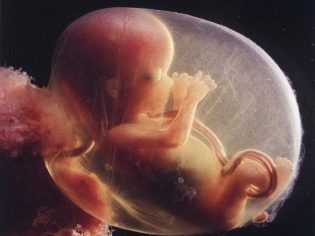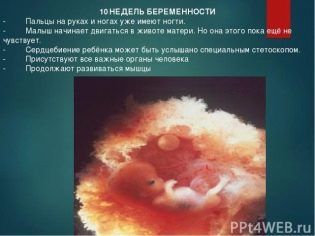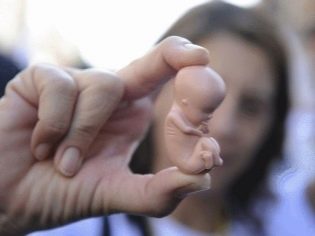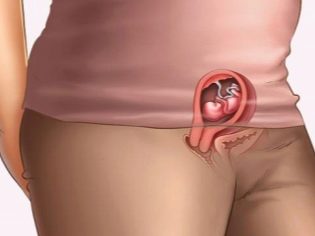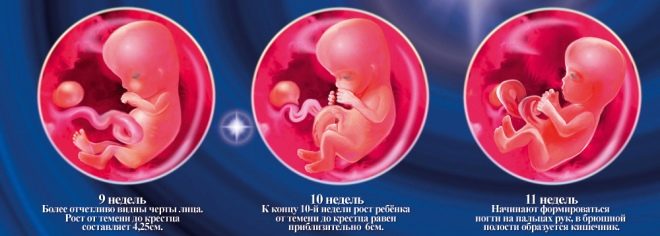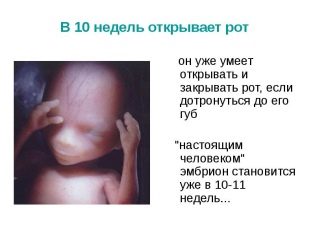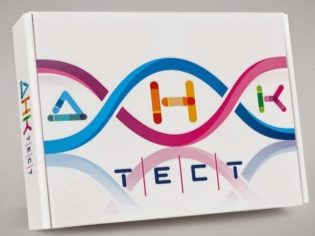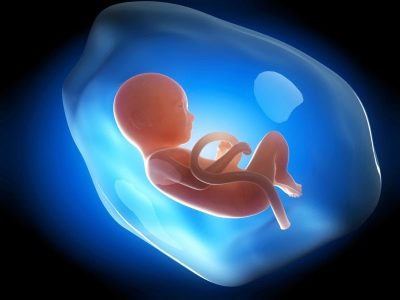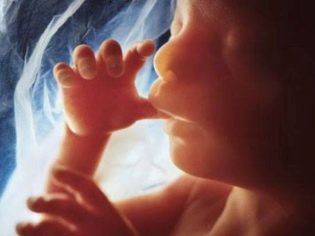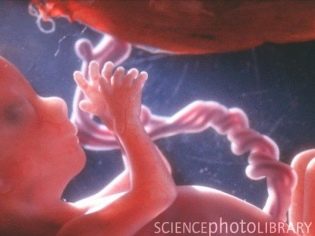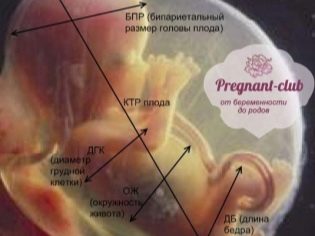Fetal development in the 10th week of pregnancy
10 week of pregnancy for a baby is a very important and crucial period. It is at this time that the embryo ceases to be such and becomes a fetus. The period of embryonic development is left behind. A new stage of the life of the baby in the womb begins - fetal.
How is the term considered?
10 weeks of pregnancy in the understanding of doctors and the same period in the understanding of expectant mothers - sometimes two completely different periods. Obstetricians and gynecologists to simplify the task as the "starting point" choose the first day of the last menstruation. Thus, there are 40 obstetric weeks in pregnancy, which corresponds to 10 lunar months.
It is clearer and more familiar for women to count pregnancy from the date of conception, or at least from the date of ovulation, since it is during this period that the long-awaited conception occurs most often. This term is called embryonic, it is about 2 weeks less than obstetric. In this way, 9-10 obstetric weeks correspond to 7-8 weeks after conception.
To avoid confusion, it is better to get used to calculate your time according to obstetric standards, because this is how gestation period will be indicated in all medical documents, tests and examination cards. All the rules with which doctors will compare the baby, also drawn up for obstetric terms.
How was the baby?
The crumb on week 10 is already quite similar to a man, only he is still very small. With the completion of the embryonic period of pregnancy, the baby's tail disappears. Now he, like his parents, has a tailbone, two legs, two hands and a head. They can be seen on ultrasound. The development of the fetus is very fast. Soon the dynamics will become slower, but so far the baby’s appearance changes almost every day.
Height and weight
At the very beginning of the tenth week of pregnancy, the baby weighs about 5 grams, and by the end of this week he will increase his weight to almost 7 grams.
The length from the crown to the tailbone at the beginning of the week is about 23 mm, and at the end of the week the baby will grow to 38 mm. Fetal growth with legs already exceeds 45 mm. To imagine the size of the fruit this week, it is enough to remember what a medium-sized plum or strawberry looks like. The baby is now just like that.
Nervous system
The nervous system of the child is now developing most intensively, because soon she will have to take over the “leadership” of the body. The spinal cord and brain are fully formed, the baby already has cranial and spinal nerves. The formation of ramifications of the neural network continues.
The main event of the 10th obstetric week is the division of the brain into hemispheres, which are now separated from the cerebellum and medulla.. The big hemispheres from this week begin to develop and improve, every day up to 250 thousand new cells appear in them.
The first neural connections have already been formed, the creation of new ones, including neuromuscular ones, continues, and soon the child’s movements will be completely controlled by his brain. This week the nervous system is divided into peripheral and central.Now, every day, the crumb will master a new skill. Already at the beginning of the 10th obstetric week, he can hold the handles to his face, touch himself. He will learn to suck a finger or cam very soon - in a couple of weeks.
Internal organs
The child was the fruit of the official level. This means that the embryonic organogenesis has been completed completely, in other words, all the organs have been formed, and now they are beginning to “master” their functional tasks.
Easier than all have a little heart. It is the first of the internal organs, the heart began to work before others. Now it has 4 chambers, a fully formed atrial septum. The heart beats at a frequency of 160 to 179 beats per minute, pumping blood through fully formed vessels.
By the way, the baby’s blood is changing this week - the development of its own white blood cells, red blood cells, and platelets begins in his body. If you need to find out the Rh factor or the group of the child, at 10 weeks it is already quite possible, having received a blood sample from the umbilical cord.
At this period, the kidneys of the baby begin to work actively. They already produce urine, accumulate it, the bladder is regularly emptied with a frequency of about once per hour. Water self-cleaning, updated every 3-4 hours.
This week the thyroid gland will start its duties. The esophagus this week is separated from the trachea, now it will connect the oral cavity and the stomach. This week, the bile ducts begin to work, the formation of the intestine, liver, pancreas is completed.
Appearance
At obstetric week, the baby's head becomes more rounded. But before the usual human species, it is still far away, because it is the head that is now the largest part of the body of the crumbs. The diameter of the head now reaches one and a half centimeters. But the individual features of the exterior — facial features — are rapidly being laid. Already there are lips, eyes, tightly covered with translucent eyelids, this week the nose and all its departments, as well as the auricles, form.
The baby already has a neck, now the baby can twist his head to the sides, and very soon he will take advantage of this opportunity. On the head this week begin to grow hair. The skin is still translucent, very thin and tender, but right now the skin becomes tactile sensitivity - nerve receptors appear and hair follicles are laid.
The arms and legs are well developed, there are tiny nails on the fingers, the elbow and knee joints are already formed and are already working. Bones of the baby are still difficult to call bones - rather, it is dense cartilage tissue. The process of compaction of the skeletal system begins on this obstetric week, and now the demand for calcium is rapidly growing.
This week a partition is formed between the abdominal and thoracic cavities - the diaphragm. The cavities themselves have become larger, more capacious, the internal organs fit into them and do not go beyond the limits.
During this period, the child may show a physiological umbilical hernia. It can speak both about congenital malformations of development, and be quite normal, the prognosis for which is quite favorable.
Child sex
The closer the end of the first trimester, the more impatient mothers become, because it will soon be possible to find out the sex of the baby. Sex is determined at the time of conception, but the internal sex glands begin to develop only closer to the second month of pregnancy. Now the formation of testicles in boys and ovaries in girls continues. There are glands in children of both sexes so far in the abdominal cavity.
In place of the external genital organs while the genital tubercle is present. It is from it that the main sex differences, the boy's penis and scrotum, or the girl's labia, are already beginning to form.
The process of formation of the genitals will be completed in about 2-3 weeks, but it’s safe to say what kind of sex a baby is, ultrasound diagnostics specialists will be able only at 15-16 weeks of pregnancy or a little later. Until this time, the probability of error due to the small size of the genitals is too high.
Everything that happens to the baby at week 10, already proceeds in the male or female type, because in his body sex hormones are already being produced. Attempts of future mothers to guess the sex of the baby’s heartbeat, more like a guessing game. The rhythm and frequency of the heartbeat from the point of view of medicine are not connected in any way with the work of the heart and vessels.
To give the most accurate answer to the question of what sex a baby can only genetic analysis, for example, a non-invasive DNA test. But the cost of such an analysis is several tens of thousands of rubles.
It’s not long to wait - after about a month and a half the truth about the baby’s gender will become apparent.
Fetal position
There is enough space in the womb for free swimming in the amniotic fluid. The baby is now located as he likes, several times a day, changing his position in the uterine cavity. Now the swimming movements and somersaults will become more and more active, because this week the young placenta begins to work fully, and the baby is connected to the mother with a strong cord of the umbilical cord.
As the crumb is, does not yet have a great diagnostic value. However, it is of considerable importance where the fertilized egg is located, in which part of the uterus it is located. This fact necessarily interests the doctor, and the place of dislocation of the placenta and the crumbs is necessarily evaluated by an ultrasound.
What did the baby learn?
At the 10-week period, the baby learned to swim. The sensations of the woman do not change because of this, until she can feel the light touch of the baby on the walls of the fetal bladder. Nevertheless, the baby is trying very hard to become truly human-like. He already knows how to open and close his mouth, brings the handles to his face, touches the umbilical cord. The process of flexion and extension of the arms, movement of the limbs - is now the main entertainment of the baby.
By the end of this week there will be another entertainment - to taste the amniotic fluid. Now there is a formation of taste buds-papillae on the tongue, very soon the baby will learn to distinguish tastes.
Fetal ultrasound at week 10
Ultrasound examinations are not relevant for this week. His women spend on their own or at the insistence of the attending physician. The indications for an ultrasound examination may be the suspicion that not one but two or three children develop in the woman’s womb, as well as the need to clarify the terms of gestation in cases where the woman has forgotten the start date of the last menstruation or had an irregular menstrual cycle.
“Verify hours” in terms of deadlines right now is necessary in order to set the date for the first prenatal screening. After a couple of weeks, the woman will have this first important study.
Also, an ultrasound scan is performed at week 10 for women who have pregnancy complications - a threat of miscarriage, a suspicion of intrauterine growth retardation, a suspicion of ectopic or undeveloped pregnancy, etc. on the image monitor.
The main indicators for this period are the average internal diameter of the ovum and the coccyx parietal size (CTR). The rules for this term are as follows.
The average internal diameter of the ovum on week 10:
Gestational age | SVD, mm |
9 weeks + 1 day | 36-37 |
9 weeks + 2 days | 38 |
9 weeks + 3 days | 39 |
9 weeks + 4 days | 40-41 |
9 weeks + 5 days | 42 |
9 weeks + 6 days | 43 |
10 weeks exactly | 44 |
Kopchiko-parietal size on the 10th week of pregnancy:
Duration of gestation (weeks and days) | KTR of norm, mm | KTP range of permissible values, mm |
9 +1 | 23,7 | 18,6 — 28,8 |
9 +2 | 25 | 19,9 — 30,2 |
9 +3 | 26,4 | 21,2 – 31,6 |
9+4 | 27,8 | 22,5 — 33,1 |
9+5 | 29,2 | 23,8 — 34,6 |
9+6 | 30,7 | 25,2 — 36,1 |
10 weeks exactly | 32,1 | 26,6 — 37,6 |
Ovaries and cervix are subject to mandatory examination for the search for probable symptoms and signs of threatened abortion. The doctor also assesses those organs of the child that can be visualized - the heart, kidneys, cerebellum, brain lobes. The size of the abdomen crumbs (OJ) does not exceed 5 mm.
In connection with the beginning of the activity of the "children's place" - the placenta, the need for a temporary organ - the yolk sac is no longer necessary. Now all the issues relating to the baby's nutrition, the supply of nutrients to him, the synthesis of hormones for his development, as well as the issues of excretion of metabolic products, "solves" a new temporary organ - the placenta. The yolk sac in the ovary begins to fade, shrink, and eventually resolves completely. This week on ultrasound can determine its size, but they no longer exceed 5 mm. The placenta itself is small. On average, its thickness at 10 obstetric weeks ranges from 9 to 17 mm, the average rate is 13 mm.
Recommendations to the future mother
Due to the fact that the active growth of bones begins at week 10, care should be taken to ensure that a sufficient amount of products containing this mineral appears in the diet. Such products include milk and cottage cheese, nuts, fresh greens, some varieties of sea fish. According to the biochemical analysis of blood, which all pregnant women take when registering, an obstetrician-gynecologist will be able to see what the calcium content in the blood of a woman is.
In hypocalcemia (calcium deficiency), calcium supplements may additionally be prescribed.
You can not take calcium without medical approval. An overdose of this mineral can cause serious problems in the future mother with the kidneys, muscles, digestion, which necessarily adversely affect the condition of the fetus.
No medication at this time can not be taken without the knowledge of the doctor, even if we are talking about harmless vitamins.. The embryonic formation of organs and systems has ended, the likelihood of mutations and deformities from taking medication is already much lower than a couple of weeks earlier, but the threat of unauthorized termination of pregnancy has not yet completely passed away, so caution should be exercised by the woman.
For the benefit of the crumbs on this period, mother’s walks in the open air are suitable, proper and balanced diet, which will not allow such troubles as constipation and diarrhea, moderately active lifestyle.
Lying on the couch is not necessary, if there are no contraindications, it is best to do Nordic walking or swimming. This will enrich the blood of a woman with oxygen, which the growing body needs now, and will help prepare for childbirth.
About the development of the child at 10 weeks of pregnancy can be found in the video below.

